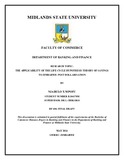Please use this identifier to cite or link to this item:
https://cris.library.msu.ac.zw//handle/11408/467Full metadata record
| DC Field | Value | Language |
|---|---|---|
| dc.contributor.author | Mpofu, Njabulo Xolisani | - |
| dc.date.accessioned | 2014-09-17T15:22:22Z | - |
| dc.date.available | 2014-09-17T15:22:22Z | - |
| dc.date.issued | 2014 | - |
| dc.identifier.uri | http://hdl.handle.net/11408/467 | - |
| dc.description.abstract | The purpose of this study was to provide banks, economic planners and policy makers with knowledge on individual’s saving behaviour so as to assist them in framing appeals accordingly. To achieve this, the study sought to test the applicability of the life cycle hypothesis of saving to Zimbabwe. The life cycle hypothesis of saving is one of the well-known theories that seek to explain individual’s saving behaviour. The study was motived by the lack of depositor confidence and the challenge of accretive transitory deposits coupled by stagnant long term deposits which have faced the country since the introduction of the Multiple Currency System (MCS) despite money supply being on an upward trend. A coalesced of the comparative and survey research design, where data was collected from a sample of 512 respondents drawn from the general public in Bulawayo and Gweru was found to be the most appropriate. Quantitative and qualitative data was collected using a combination of questionnaires, interviews and secondary data from the 2012 national census and Poverty Income Consumption and Expenditure Survey (PICES) 2011/12. This data was analysed using a combination of MS Excel, Stata 12, thematic and content analysis. The results of the study revealed that the major motive for saving during an individual’s working years is for the purchase or construction of land and housing. Saving for life after retirement was the fourth most common motive for saving coming after the saving for children’s education and the precautionary motive. Furthermore, the results found that the primary source of income during retirement was business, professional and farming profits. In line with the life cycle hypothesis, income followed a ‘humped’ pattern peaking in middle age. However, income did not exceed consumption in the middle age contrary to the life cycle hypothesis. Moreover, the study revealed that age varies with asset holding in a ‘wave’ shaped pattern. Despite the actual results suggesting that the life cycle hypothesis is not applicable, the study found that if one goes by people’s intentions and attitudes the life cycle hypothesis was applicable in Zimbabwe. Given that the life cycle hypothesis is not applicable in Zimbabwe, banks are therefore advised to frame appeals for the purchase or construction of land and housing for cohorts in the 25-44 year age group. Banks can frame appeals on retirement products to those approaching retirement as this motive only becomes dominant as people approach retirement. Lastly, the study recommends banks to raise awareness of ‘pay yourself first’ in addition to educating people how to save for retirement. | en_US |
| dc.language.iso | en | en_US |
| dc.publisher | Midlands State University | en_US |
| dc.subject | Post dollarisation | en_US |
| dc.title | The applicabilty of the life cycle hypothesis theory of savings to Zimbabwe: post dollarisation | en_US |
| item.fulltext | With Fulltext | - |
| item.languageiso639-1 | en | - |
| item.grantfulltext | open | - |
| Appears in Collections: | Bachelor Of Commerce Banking And Finance Honours Degree | |
Files in This Item:
| File | Description | Size | Format | |
|---|---|---|---|---|
| Final Draft.pdf | 595.59 kB | Adobe PDF |  View/Open |
Items in MSUIR are protected by copyright, with all rights reserved, unless otherwise indicated.



